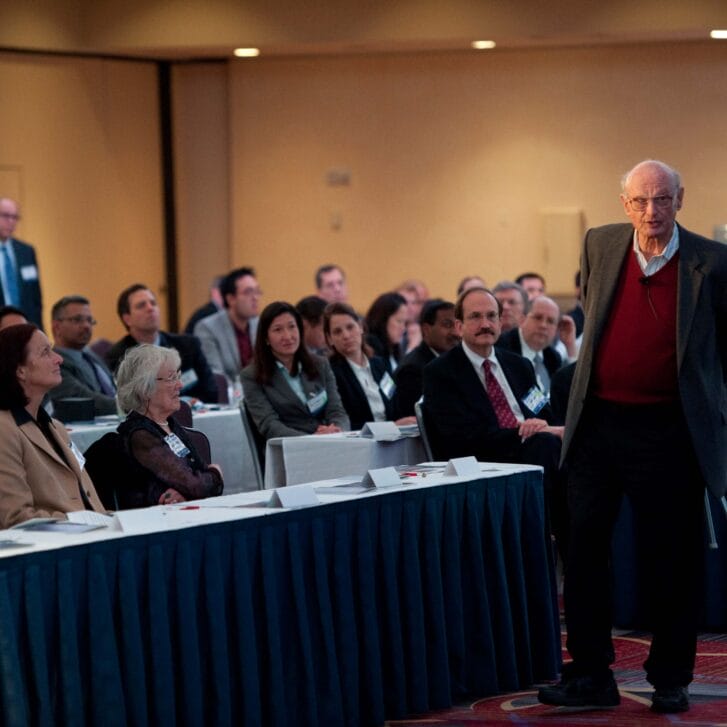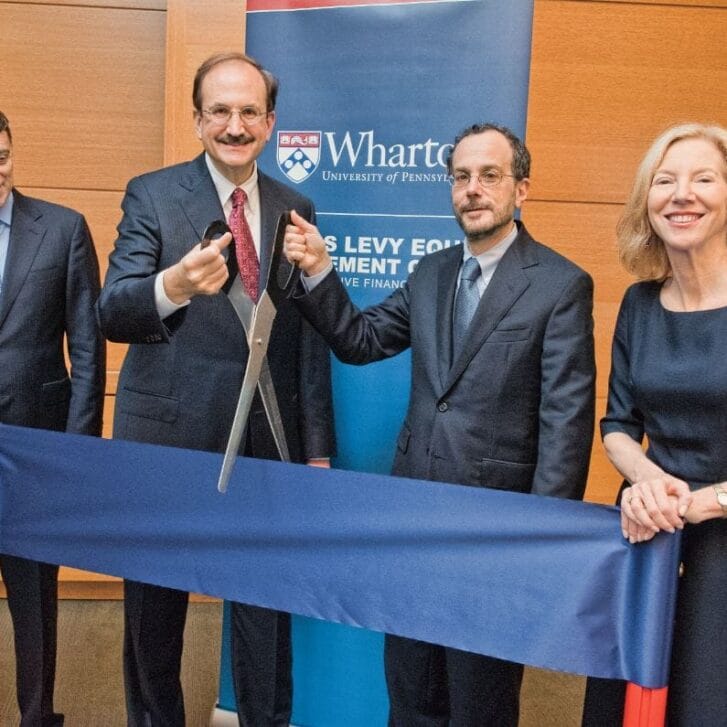Remember Lippincott Library? It’s Changed
After nine months of construction and seven years of fund raising and planning, Wharton’s Lippincott Library this spring unveiled its brand new state-of-the-art facility.
The renovated Lippincott, which is now considered by some the most advanced business library in the U.S., houses a wealth of electronic and traditional resources in a single 20,000 square-foot facility.
At the heart of the space is the $2 million Safra Research Center, a gift of the Safra Family and Republic National Bank. Within the newly renovated Center are 32 Pentium-class workstations connected to 100 databases, 44 stations in carrels and study rooms with electric and network connections for laptop computers, eight laser printers and three dedicated CD-ROM stations. Each workstation is a gateway to the Penn Library Information Network, the World Wide Web and other Internet resources.
 The library also contains extensive reference collections in print, including 220,000 volumes and about 10,000 reference books.
The library also contains extensive reference collections in print, including 220,000 volumes and about 10,000 reference books.
The Safra Center is intended to be student-friendly as well as research-friendly. Chairs are padded and carpets line the floors; soft lighting is designed to work well with computer screens; and carrels, tables and shelves are made of cherry wood. Two large seminar rooms, equipped with the most advanced computer projection equipment and computer workstations, and four group study rooms complete the Center’s additions.
The Lippincott Library is the first in a series of projects to transform the larger Van Pelt/Dietrich facility, where Lippincott and Penn’s social science library are housed. A $7.5 million renovation of Van Pelt/Dietrich’s first floor is already underway and should be completed in two years.
“Since the renovations, usage of Lippincott has increased tremendously,” says Michael Halperin, Lippincott director. “We’re delighted with the space in terms of its ability to make electronic resources available to students in a way we weren’t able to do before.”
Lauder Institute Gets $10 Million Gift
Leonard Lauder, president and CEO of Estee Lauder Co., has given an additional $10 million to the Joseph H. Lauder Institute of Management and International Studies.
The Lauder Institute, a 24-month dual degree program that includes a Wharton MBA and an MA in International Studies from Penn’s School of Arts and Sciences, was established in 1983 with a $10 million gift from Leonard and Ronald Lauder. The Institute honors their late father, Joseph H. Lauder, founder of the New York-based Estee Lauder Companies.
The Lauder Institute has been a pioneer in recognizing the importance of integrating management, language and international studies. “There truly is a global economy,” Leonard Lauder stated when he made the initial gift. “And we had better be trained to handle the problems and opportunities which such international trade has created. One good area to start is in our universities, the training area for tomorrow’s managers.”
Today, more than 500 Lauder graduates are spread out in 63 countries in industries ranging from finance and consulting to consumer goods and multimedia management.
The new gift will take international management education to the next level by further developing international studies, foreign language and cross-cultural aspects of the curriculum.
Computers Take Center Stage
Computers and the brave new world of electronic commerce were the subject of two different conferences held on campus in May.
“The Impact of Computers and Information on Management,” sponsored by Wharton’s SEI Center for Advanced Studies in Management and nine other research centers, drew together a distinguished list of panelists and speakers, including:
James Unruh, chairman and CEO of Unisys Corp.; Paul Allaire, chairman and CEO of Xerox; John Seely Brown, vice president and chief scientist at Xerox Palo Alto Research Center; John Sculley, chairman and CEO of Sculley Associates, Inc.; Alfred West, chairman and CEO of The SEI Corp.; Howard Frank, director of the Information Technology Office, ARPA; Mark Goldstein, CEO of NetAngels.com and chairman of the Interactive Services Association; Henry Sweetbaum, chairman and CEO of Wickes, Plc., and PeiYuan Chia, senior executive and vice chairman of Citibank, N.A.
Discussion focused on the impact of computers on executives’ lives, business and society.
“Beyond the Hope and the Hype: Creating a New Market Reality” looked at a variety of issues related to electronic commerce, including business-to-business markets, advertising, customer/company interaction, the demographics of Internet users, and the impact of electronic commerce — which is expected to reach $45.8 billion by the year 2000 — on public policy issues.
Panelists included Jim Manzi, chairman of Industry.Net and former chairman of Lotus Development Corp.; Christine A. Varney, commissioner of the U.S. Federal Trade Commission; John Evans, chairman of Middlegate; Peter Granoff, founder and master sommelier of Virtual Vineyards, and representatives from Hewlett-Packard, Forrester Research, Inc., AT&T, ASI Market Research and Strategic Interactive.
Both conferences were reported “live” on the world wide web, with summaries and photos posted continuously on conference pages linked to Wharton’s home page (http://wharton.upenn.edu).
Grade A Teaching
Organizers of both Spring Salute in April and Commencement in May took the opportunity to honor recipients of the 1996 awards for teaching excellence in Wharton’s undergraduate and graduate divisions.
This year’s David W. Hauck Award for Outstanding Teaching in the undergraduate division went to Abba M. Krieger, professor of statistics and operations research, operations and information management, and marketing; and Philip M. Nichols, Ronald Koenig Term Assistant Professor of Legal Studies. The $15,000 award recognizes professors’ ability to lead, stimulate and challenge students, their knowledge of the latest research in the field and their commitment to educational leadership.
Undergraduate Division Excellence in Teaching Awards, given to honor outstanding teaching and exceptional commitment based on undergraduate student nominations and teaching evaluations, went to:
Suleyman Basak, assistant professor of finance; Gordon M. Bodnar, assistant professor of finance; Jamshed K.S. Ghandhi, associate professor of finance; William F. Hamilton, Ralph Landau Professor of Management and Technology; Robert W. Holthausen, Nomura Securities Co. Professor of Accounting and Finance; Larry W. Hunter, Paul Yeakel Term Assistant Professor of Management; Abba M. Krieger; William S. Laufer, associate professor of legal studies; Philip M. Nichols, and Jeremy J. Siegel, professor of finance.
 The Marc and Sheri Rapaport Undergraduate Core Teaching Award, given for excellence in a core course in the undergraduate division, went to Janice Eberly, James G. Campbell, Jr. Memorial Term Assistant Professor of Finance.
The Marc and Sheri Rapaport Undergraduate Core Teaching Award, given for excellence in a core course in the undergraduate division, went to Janice Eberly, James G. Campbell, Jr. Memorial Term Assistant Professor of Finance.
On the graduate level, the Helen Kardon Moss Anvil Award, recognizing exceptional teaching effort and ability both inside and outside the classroom, went to Howard Kaufold, adjunct associate professor of finance and director of Wharton’s Executive MBA program, and Jeremy J. Siegel.
 Graduate Division Excellence in Teaching Awards, presented to the eight professors with the highest ratings from MBA student course evaluation forms, went to:
Graduate Division Excellence in Teaching Awards, presented to the eight professors with the highest ratings from MBA student course evaluation forms, went to:
Franklin Allen, Nippon Life Professor of Finance and Economics, who, as recipient of the highest ratings among the eight, also won the Class of 1984 Teaching Award; Michael R. Gibbons, I.W. Burnham II Professor of Investment Banking; Howard Kaufold; William L. Kissick, Professor of Health Care Systems; David J. Reibstein, William Stewart Woodside Professor of Marketing; Jeremy J. Siegel; William C. Tyson, associate professor of legal studies, accounting, management and real estate; and Karl Ulrich, associate professor of operations and information management.
Undergrads Hit a Winning Streak
Three strikes and you’re out. Or, in this case, three victories and you’re out.
The game here is the 15th McIntire International Case Competition held every winter in Charlottesville, Va. The victory was a first-place finish in the competition — for the third year in a row — by a team from Wharton. Under competition rules, any team that wins three consecutive times is not invited back the next year.
 The Wharton contingent — which included captain Artem Mikhlin, W’97, Michael Gerstner, W’97, Tejal Mody, W’96, and Brett Pogany, W’97 — competed against teams from the University of Virginia’s McIntire School of Commerce, the University of Waikato in New Zealand, the University of Minnesota’s Carlson School of Management, the University of Manchester (England) School of Management and Hampton University School of Business.
The Wharton contingent — which included captain Artem Mikhlin, W’97, Michael Gerstner, W’97, Tejal Mody, W’96, and Brett Pogany, W’97 — competed against teams from the University of Virginia’s McIntire School of Commerce, the University of Waikato in New Zealand, the University of Minnesota’s Carlson School of Management, the University of Manchester (England) School of Management and Hampton University School of Business.
Each team had several days to prepare a business plan based on information developed especially for the competition by professors from McIntire. “The case was about a real-life navigation equipment company in Charlottesville, Va., called Sperry Marine, Inc. which makes electronic navigation and guidance systems for commercial and military customers,” says Mikhlin. “John Lehman, former Secretary of the Navy, had decided to form a venture capital group to buy niche players in the defense industry. Our challenge was to come up with an answer as to whether he should buy Sperry, and if so, for how much?”
Each team was given a 70-page document on the company, including data on its financials, products, industry standing, strengths and weaknesses, and so forth. The teams then announced their findings in a five-page paper followed by an oral presentation.
“We looked at the numbers, the management and the synergies that were available,” says Mikhlin. “We valued the company at $60 million although we knew it might go for more. Our rationale was that it was a subsidiary of another company which had a lot of debt and was desperate to sell off some of its assets, including Sperry.
“Part of our plan was for Lehman to buy the company, straighten it out, build it up, and then flip it quickly.”
Which is close to what actually happened. Lehman bought Sperry for $78 million and two years later sold it to Litton Industries for more than twice his initial investment.
Mikhlin, who will graduate in 1997 from the Jerome Fisher Program in Management & Technology, is looking at careers in management consulting or finance. This summer he is working in the financial derivatives department at Enron in Houston. “I’m interested in finance, but after taking part in this case competition, I think consulting might be more fun. At this point, I’m undecided.”
Hands-On Help
Meet Gertrude Davis, a retired nurse who is raising five great grandchildren in her West Philadelphia rowhouse. Davis was one of 33 Philadelphia homeowners helped by the 1996 “Christmas in April” program which every year renovates the houses of low-income, elderly and disabled families in Philadelphia. Approximately 700 Wharton students, Dean Thomas P. Gerrity and other volunteers from the Penn community and surrounding neighborhood turned out on April 20 to scrape, paint, tear down, repair and remodel.
Campus News
– Commencement ceremonies drew two prominent industry leaders to campus this spring to speak at graduate and undergraduate events.
Brian Roberts, W’81, president of Comcast Corp., a leading cable television/telecommunications company, spoke at this year’s Ivy Day celebration on May 18. Edgar Bronfman, Jr., president and CEO of The Seagram Co. Ltd., delivered the MBA commencement address on May 21.
Roberts is a board member of the Turner Broadcasting System, QVC and Viewer’s Choice. He is also chairperson of the National Cable Television Association and vice-chairperson of the Walter Kaitz Foundation, which trains minorities for employment in the cable television industry.
Ivy Day honors four male and four female seniors who are chosen by their classmates for overall excellence and campus involvement.
Bronfman is a member of the boards of The New York Public Library, NYU Medical Center, the Teamwork Foundation, WNET/Thirteen, the Solomon R. Guggenheim Foundation and Wharton.
– Wharton’s faculty has approved a new undergraduate joint degree program with Penn’s School of Nursing which will offer a BS in Economics and a BS in nursing in four years.
Students who apply to the program must meet admissions requirements of both Wharton and the School of Nursing. Approval of this initiative means that Wharton now has a specially designed undergraduate joint degree program with each of Penn’s undergraduate schools.
– Wharton’s ties to the Asian business community received a boost this spring with a $1.6 million gift to endow the Liem Sioe Liong/First Pacific Company Professorship.
The gift came from Anthony Salim, president and CEO of the Salim Group, one of the largest Indonesian conglomerates, and its associated Hong Kong-based First Pacific Co., whose managing director is Manuel V. Pangilinan, WG’68. The professorship is named after Salim’s father, Liem Sioe Liong, and the First Pacific Company.
The Salim Group is one of the largest business groups in Indonesia and Southeast Asia. It employs more than 200,000 people in 11 business divisions, including agribusiness, financial services, chemicals and trading and distribution.
– Applications to Wharton’s undergraduate program were 20 percent higher than last year, and MBA applications, which totaled 6,354 in 1995, came in at a record 7,329.
The MBA admissions staff conducted interviews in 12 countries this year, including, for the first time, Argentina. The average GMAT score rose nine points, and the average age of applicants increased more than one-half year.
Meanwhile applications to the executive MBA program (WEMBA) also boomed, up 23 percent over last year.
In executive education, a record 12,000 executives are participating in open enrollment programs.

























